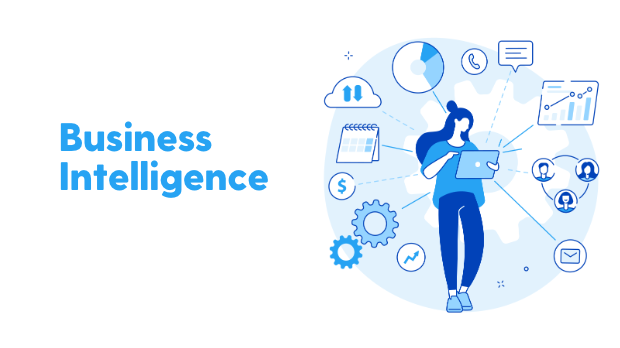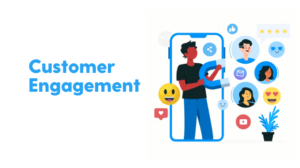Business Intelligence (BI) is a set of processes, tools, and techniques that transform raw data into meaningful and actionable insights for better decision-making. BI aims to help organizations analyze their data to gain a deeper understanding of their business performance, identify trends, uncover opportunities, and optimize operations.
BI involves collecting data from various sources, such as internal databases, external sources, and transactional systems. This data is then integrated, cleaned, and stored in a data warehouse or other storage system. Analytical tools are used to process and analyze the data, identifying patterns and relationships that provide valuable insights into the business.
Data visualization is a critical aspect of BI, as it allows decision-makers to quickly and easily interpret the insights gleaned from the data analysis. BI tools and platforms often include interactive dashboards, charts, and graphs that present key performance indicators (KPIs) and other relevant metrics in a visually appealing and accessible format.
BI Use Cases
Nine important use cases of using business intelligence are:
| Function | Data | Metric | Technique |
| Sales and Revenue | Sales data, customer data | Sales revenue, growth rate | Trend analysis, forecasting |
| Marketing | Campaign data, web analytics | ROI, conversion rate | Segmentation, A/B testing |
| Finance | Financial data, budget data | Profit margin, expenses | Variance analysis, budgeting |
| Customer Service | Support tickets, customer feedback | Resolution time, satisfaction | Text analytics, sentiment analysis |
| Operations | Production data, inventory data | Efficiency, capacity utilization | Process mining, optimization |
| Human Resources | Employee data, performance data | Turnover rate, productivity | Attrition modeling, workforce planning |
| Supply Chain | Supplier data, logistics data | Lead time, order fulfillment | Network optimization, inventory analysis |
| Risk Management | Financial data, compliance data | Risk exposure, compliance | Risk scoring, scenario analysis |
| Product Development | Product data, customer feedback | Time to market, adoption rate | Feature analysis, prototyping |
Benefits of BI
Business Intelligence (BI) has widespread applications across businesses of all types and sizes. To understand the benefits BI brings to an organization, let’s look holistically at one type of business and apply the above use cases.
Business Intelligence (BI) offers numerous benefits to eCommerce businesses by providing valuable insights that drive informed decision-making.
Six Benefits of BI, along with Relevant Examples, are:
- Improved decision-making: BI helps eCommerce businesses make data-driven decisions by providing a comprehensive view of their performance. For example, an online fashion store can use BI to analyze sales data and identify top-selling products or customer segments, enabling them to focus their marketing efforts and inventory management on high-demand items.
- Increased sales and revenue: By identifying trends, customer preferences, and effective marketing strategies, BI can help eCommerce businesses increase their sales and revenue. For example, an online electronics retailer can use BI to analyze historical sales data and create personalized product recommendations for customers, leading to higher conversion rates and average order values.
- Enhanced customer experience: BI can help eCommerce businesses gain insights into customer behavior, preferences, and pain points, allowing them to improve the overall customer experience. For instance, a furniture retailer can use BI to analyze customer feedback and website data to identify common issues in the purchasing process, such as confusing navigation or slow page load times, and take corrective actions to address these problems.
- Efficient inventory management: BI can assist eCommerce businesses in optimizing their inventory levels by analyzing sales patterns, seasonal trends, and stock levels. For example, an online grocery store can use BI to forecast demand for specific products, ensuring that they maintain optimal inventory levels and reduce the risk of stockouts or overstocking.
- Cost reduction: By identifying inefficiencies and areas for improvement, BI can help eCommerce businesses reduce costs and streamline their operations. For example, an online apparel retailer can use BI to analyze shipping costs and delivery times, enabling them to negotiate better deals with logistics providers or find more cost-effective shipping options.
- Better understanding of customer segments: BI can help eCommerce businesses analyze customer data to identify distinct segments based on factors like demographics, purchasing behavior, and preferences. For instance, an online cosmetics store can use BI to segment customers by age, product preferences, and purchase frequency, allowing them to create targeted marketing campaigns that resonate with each segment.
BI Tools & Platforms
here are many options to choose from when shopping for a BI platform. Listed below are a few important features the choice BI platform must have.
- Data Integrations
A BI tool should connect to many data sources with optimized native connectors. - Data Management
Data management generally involves exploring, cleaning, and blending data from different sources to conduct analysis. The ideal BI tool should be able to efficiently manage metadata and perform data transformations, making it easy for the end user. - Data Visualization & Reporting
The BI solution should allow for creating interactive dashboards with a wide range of charting options. Users should be able to slice and dice OLAP analysis, drill down through reports, and use special formatting to highlight data exceptions without emphasizing additional learning and supervision. The platform should also facilitate scheduled report refreshes, automatic email updates, built-in alerts when specific criteria are met, etc. - Location Intelligence
The choice BI solution should have embedded geospatial intelligence for map-based visualization and analysis. - Cross-platform Compatibility Compatibility that permits file sharing between devices and across platforms is an essential feature of a BI tool. This feature will also be important in creating a collaborative working environment.
- User-Specific Security
The BI tool of choice should make it easy to manage platform users, be flexible with providing different users with varying levels of access to data sets and allow for customizable security features for user groups. - Mobile Support
The BI platform should allow users to publish reports to mobile terminal devices and take advantage of mobile devices’ functions to implement touch operations, page positioning, etc. - Cloud-based Solution
A BI tool should also be cloud-based, allowing users to access reports from any device at any time.
Pro-User Features
- Advanced Analytics
An ideal BI platform should be able to handle complex data manipulations and leverage artificial intelligence, data mining, and machine learning for regression, statistical and prediction analysis, what-if analysis, etc. - Augmented Analysis
A BI tool should take advantage of Augmented analysis, which deploys ML-based automation to improve data profiling and quality. Users can automatically find new trends and cohorts within the dataset and set up alerts when a drastic change in datasets/existing rules is observed.
Power BI vs Tableau vs Data Studio
There are many players in the BI space, like Salesforce (Tableau), Microsoft (Power BI), Google (Google Charts, Data Studio), Oracle, IBM, Si (SiSense), Qlik (QlikSense), and many more.
The following comparison is limited to platforms we garnered the most experience with. The comparison between popular BI tools spans 15+ performance indicators that organizations should consider before signing on to a BI platform:
| Power BI (Microsoft) | Tableau (Salesforce) | Looker / Data Studio (Google) | |
| Subscription Tiers & Cost | Desktop: Free, Pro: $13.70, Premium: $27.50 | Viewer: $15, Explorer: $42, Creator: $70 |
Free |
| Data Source Integrations | Has support for all the major data sources | Has support for all the major data sources | Limited on accepting cloud-based partners natively. However, Google lets its partners create connectors for a fee. |
| Data Modelling and Transformation Capability | Has built-in ETL tools like Power Query and DAX | Limited of ETL and modeling functionality | Very limited on functionality. Allows for combining data from various sources using JOIN key. |
| File Sizes | Can handle data up to 10 GB. If the dataset is > 10GB, PBI establishes a direct connection without importing the data. | Works on columnar-based structure, storing only the unique values in a column. | Limited to 20,000,000 rows |
| Data Handling Capacity | Limited on handling data of size | Better performance with large datasets | Very limited on handling data of size |
| Ease of Learning | Medium | Difficult | Very Easy |
| User Interface | Relatively easy to use. Needs minimal training | Moderately difficult to use. Additional training is recommended | Very easy to use. Takes a drag-and-drop approach to building visuals. Requires very minimal training |
| Ease of Data Visualization | Medium | Difficult | Very Easy |
| Level of Customization on Visuals | Limited on customization | Allows for a greater level of customization | Very Limited on customization |
| Deployment Language | DAX | MDX | – |
| Programming Support | Supports R language-based visualizations | Supports R and Python language-based visualizations | Very limited on programming support |
| Support for Open-Source Custom Visuals | Yes | Yes | Yes |
| Mobile App | Yes | Yes | Yes |
| Built-in Row Level Security | Yes | Yes | Yes |
| Special Features | Offers features like Q & A using the natural language features, Power Pivot. Allows for 3rd party-developed customer visuals. Microsoft releases OTA updates regularly. Has advanced ML Features | Has features like Regression and predictive analysis built in. Has VizQL and Hypertechnology that can optimize the visuals for better performance with large datasets. | – |
| Training Avenues | In Person, Live Online, Webinars, Documentation, Videos | In Person, Live Online, Webinars, Documentation, Videos | Videos |
| Customer Support | Limited support for users on the free tier. Customer support gets significantly better for paid users. Has an active community forum. | Has excellent community support | Limited on support from Google. Has good community support |
| Avenues for Support | Email/Help Desk, FAQ/Forums, Knowledge base, Phone Support, Live Rep., Chat | Email/Help Desk, FAQ/Forums, Knowledge base, Phone Support, Live Rep., Chat | Email/Help Desk, Knowledge base |
Which BI Platform to Choose
Power BI, Tableau, and Data Studio are market leaders and have pushed the needle forward with data analytics and visualization.
There is no definitive answer: What is the best business intelligence tool?
We have narrowed the scope of this analysis to the market leaders. However, depending on business needs, one is preferred.
Power BI is recommended for individuals and SMB organizations due to the lower entry barrier for a subscription. Users and businesses familiar with Microsoft’s ecosystem will find PBI highly intuitive.
Tableau is the way to go for organizations that are rigorous with their reporting, need a high bandwidth for data, and demand greater customizability with the reports. Medium to Large organizations should be able to justify higher subscription prices.
Data Studio is ideal for users and organizations who prefer ad-hoc analysis over fully structured static dashboards, want a drag-and-drop interface, and rely on G-Suite and other Google services. Despite its low data handling capabilities, it is a serious option for small-size companies due to its no-subscription requirement.
Challenges of BI
While Business Intelligence (BI) offers numerous benefits to businesses, it also presents certain challenges and limitations. Businesses can effectively transform data into revenue-generating actions by understanding these challenges and taking a holistic approach. Some of the challenges and limitations include:
- Data quality and accuracy: Inaccurate, incomplete, or outdated data can lead to misleading insights and poor decision-making. Ensuring data quality is a critical challenge for businesses implementing BI. A holistic approach involves implementing robust data governance policies and processes to ensure data is accurate, complete, and up-to-date.
- Data integration: Integrating data from various sources and systems can be complex and time-consuming. Businesses must invest in the right tools and technologies to effectively integrate and consolidate their data for BI purposes. This involves utilizing modern data stack solutions to enable seamless data integration across various platforms.
- Data privacy and security concerns: Handling sensitive data and maintaining privacy and security can be challenging for businesses implementing BI. Establishing strong security measures, encryption protocols, and adhering to compliance regulations are essential to ensure data privacy and security.
- Skill gaps and resource constraints: Implementing BI requires a skilled team with data analytics, data engineering, and visualization expertise. Businesses may face challenges in hiring or training the necessary talent. A holistic approach involves partnering with a trusted data partner, like Saras Analytics, to provide the required expertise and support.
- Adoption and change management: Introducing BI into an organization may face resistance from employees who are unfamiliar with data-driven decision-making. Ensuring smooth adoption and integration of BI practices requires effective change management strategies, employee training, and fostering a data-driven culture.
- Scalability and flexibility: As businesses grow and evolve, their BI needs change as well. Businesses must ensure their BI infrastructure is scalable and flexible to adapt to these changes. Adopting a modern data stack and cloud-based solutions can enable scalability and support future growth.
Conclusion
Business Intelligence (BI) plays a crucial role in enabling businesses to make data-driven decisions and optimize their operations. A modern data stack is critical for effectively implementing BI, as it provides the necessary tools and infrastructure to collect, process, analyze, and visualize data.
Saras Analytics is an end-to-end data partner that can help businesses harness the power of BI by providing a modern data stack and expert support. By leveraging Saras Analytics’ expertise and solutions, businesses can gain valuable insights, drive growth, and stay ahead in the competitive eCommerce landscape. Contact us today and unlock the full potential of your business through the power of Business Intelligence.













